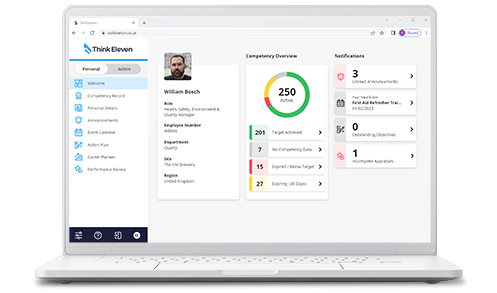Career Planning
Empowering and engaging ownership of career development

What is Career Planning?
Career planning is a strategic process designed to help individuals navigate their professional journey, maximising their potential and growth opportunities as they progress in their careers. It involves identifying and aligning personal aspirations, skills, and interests with the wider organisational goals and opportunities. By proactively charting a path for career advancement and development, individuals can effectively leverage their talents and capabilities to achieve their professional objectives and aspirations.
The career planning tools within SkillStation empowers employees to take ownership of their career trajectory, ensuring they are well-positioned to thrive and succeed in their chosen field.
Career planning holds significant importance for both individuals and employers due to the following reasons:
- Retaining Talent: Without structured career planning, individuals may outgrow their current roles, leading to disengagement, decreased motivation, and ultimately, attrition. By proactively guiding employees' career paths, organisations can more effectively retain top talent and minimise turnover.
- Optimising Talent Utilisation: Effective career planning enables employers to identify and leverage the full potential of their workforce. By aligning employees' skills, aspirations, and organisational needs, employers can maximise productivity, innovation, and overall performance.
By prioritising career planning initiatives, organisations can cultivate a motivated and engaged workforce while ensuring their long-term success and competitiveness in the market.
Those with a desire to develop and grow within your organisation will have the opportunity to flourish while feeling valued, and being able to make a positive contribution.
When performed well, effective career planning and staff development demonstrates an organisational culture of recognising, valuing and rewarding your people, making you an employer of choice.
This in-turn will improve staff retention and reduce the need to recruit externally, which brings the associated risk and cost.
The Career Planning module within SkillStation allows both the employee (individual) and departmental/function managers to review the opportunity to develop talent across the organisation in a visual and user-friendly way.
SkillStation delivers simple and user-friendly self-service career planning. It allows people to review and compare their current capabilities against:
- The training, skills and competencies for their current role
- Any other role made publicly available to the workforce
People can quickly and easily compare their range of knowledge, skills and competencies against wider roles available, to identify their suitability and gaps.
SkillStation will also show any previously-defined user objectives that exist for a skill, plus any training scheduled in the Event Calendar module (Training Plan). This allows the employee to request training attendance to help close skill gaps.
Line-managers and SkillStation administrators can review and test scenarios. For example:
- Compare employee capability against job role expectations to see the extent of the gap or alignment, therefore allowing you to make development or promotional decisions
- Look at opportunities for succession planning where the gap may be either zero or minimal, and therefore a good match
- Create new roles based around scenarios such as restructure, to explore whether existing people are capable of (or close to) fulfilling the newly-defined roles)
- Look at career planning in advance of any performance appraisals if members of your team have career development aspirations
- Look at multi-skilling certain roles, e.g. one person; two jobs versus one person; one job
